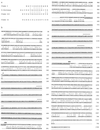Ribonucleotide reductase in the archaeon Pyrococcus furiosus: a critical enzyme in the evolution of DNA genomes?
- PMID: 9012808
- PMCID: PMC19537
- DOI: 10.1073/pnas.94.2.475
Ribonucleotide reductase in the archaeon Pyrococcus furiosus: a critical enzyme in the evolution of DNA genomes?
Abstract
Ribonucleotide reductase (RNR), the enzyme responsible for deoxyribonucleotide synthesis, has been isolated from Pyrococcus furiosus, a deeply branching hyperthermophilic, strictly anaerobic archaeon. Its gene has been cloned, sequenced, and shown to harbor two insertions encoding inteins. The purified enzyme absolutely requires adenosylcobalamin for activity, a trait that defines it as a member of class II (adenosyl-cobalamin-dependent) prokaryotic RNRs. On the other hand, the archaeal RNR has significant amino acid sequence homology with class I (aerobic non-heme iron-dependent) and class III (anaerobic iron-sulfur-dependent) RNRs present in eukaryotes and bacteria, respectively. It is proposed that this enzyme may be the closest possible relative of the original RNR, which allowed the key "RNA world" to "DNA world" transition, and that the different classes of present-day RNRs are the products of divergent evolution.
Figures


Similar articles
-
Ribonucleotide reduction - horizontal transfer of a required function spans all three domains.BMC Evol Biol. 2010 Dec 10;10:383. doi: 10.1186/1471-2148-10-383. BMC Evol Biol. 2010. PMID: 21143941 Free PMC article.
-
Ribonucleotide reductases: divergent evolution of an ancient enzyme.J Mol Evol. 2002 Aug;55(2):138-52. doi: 10.1007/s00239-002-2311-7. J Mol Evol. 2002. PMID: 12107591
-
Analysis of transcription of the Staphylococcus aureus aerobic class Ib and anaerobic class III ribonucleotide reductase genes in response to oxygen.J Bacteriol. 2001 Dec;183(24):7260-72. doi: 10.1128/JB.183.24.7260-7272.2001. J Bacteriol. 2001. PMID: 11717286 Free PMC article.
-
Structure and function of the radical enzyme ribonucleotide reductase.Prog Biophys Mol Biol. 2001 Nov;77(3):177-268. doi: 10.1016/s0079-6107(01)00014-1. Prog Biophys Mol Biol. 2001. PMID: 11796141 Review.
-
Structure, function, and mechanism of ribonucleotide reductases.Biochim Biophys Acta. 2004 Jun 1;1699(1-2):1-34. doi: 10.1016/j.bbapap.2004.02.007. Biochim Biophys Acta. 2004. PMID: 15158709 Review.
Cited by
-
Diversity in Overall Activity Regulation of Ribonucleotide Reductase.J Biol Chem. 2015 Jul 10;290(28):17339-48. doi: 10.1074/jbc.M115.649624. Epub 2015 May 13. J Biol Chem. 2015. PMID: 25971975 Free PMC article.
-
Posttranslational protein modification in Archaea.Microbiol Mol Biol Rev. 2005 Sep;69(3):393-425. doi: 10.1128/MMBR.69.3.393-425.2005. Microbiol Mol Biol Rev. 2005. PMID: 16148304 Free PMC article. Review.
-
Introns and intein coding sequence in the ribonucleotide reductase genes of Bacillus subtilis temperate bacteriophage SPbeta.Proc Natl Acad Sci U S A. 1998 Feb 17;95(4):1692-7. doi: 10.1073/pnas.95.4.1692. Proc Natl Acad Sci U S A. 1998. PMID: 9465078 Free PMC article.
-
Modular organization of inteins and C-terminal autocatalytic domains.Protein Sci. 1998 Jan;7(1):64-71. doi: 10.1002/pro.5560070106. Protein Sci. 1998. PMID: 9514260 Free PMC article.
-
The cbiS gene of the archaeon Methanopyrus kandleri AV19 encodes a bifunctional enzyme with adenosylcobinamide amidohydrolase and alpha-ribazole-phosphate phosphatase activities.J Bacteriol. 2006 Jun;188(12):4227-35. doi: 10.1128/JB.00227-06. J Bacteriol. 2006. PMID: 16740929 Free PMC article.
References
-
- Reichard P. Science. 1993;260:1773–1777. - PubMed
-
- Berglund O, Eckstein F. Eur J Biochem. 1972;28:492–496. - PubMed
-
- Thelander L, Sjöberg B-M, Eriksson S. Method Enzymol. 1978;51:227–237. - PubMed
-
- Borges K M, Brummet S R, Bogert A P, Davis M C, Hujer K M, Domke S T, Szasz J, Ravel J, DiRuggiero J, Fuller C, Chase J W, Robb F T. Genome Sci Technol. 1996;1:37–46.
-
- Cherry J L, Young H, DiSera L J, Ferguson F M, Kimball A W, Dunn D M, Gesteland R F, Weiss R B. Genomics. 1994;20:68–74. - PubMed
Publication types
MeSH terms
Substances
Associated data
- Actions
LinkOut - more resources
Full Text Sources
Other Literature Sources
Molecular Biology Databases

